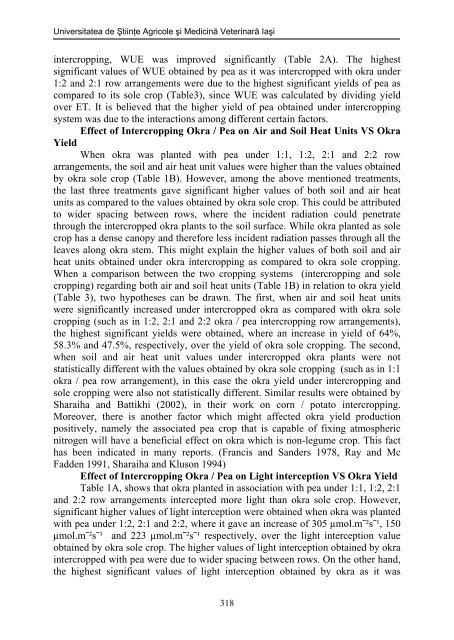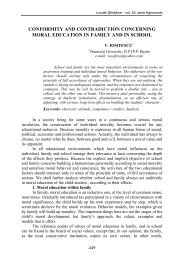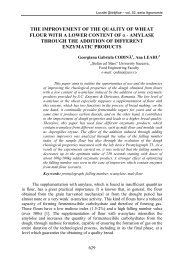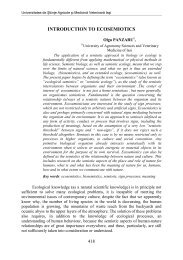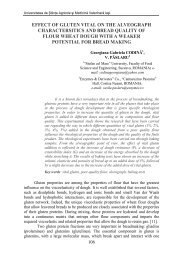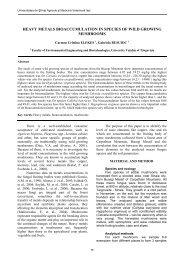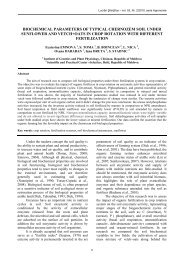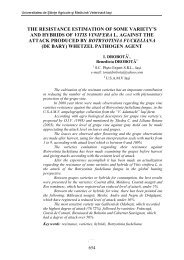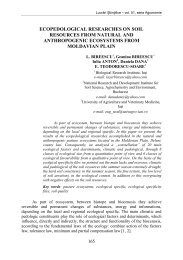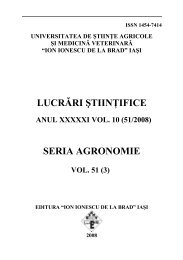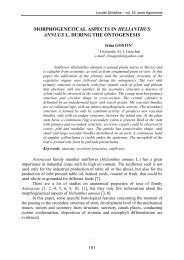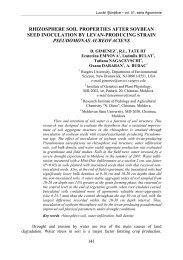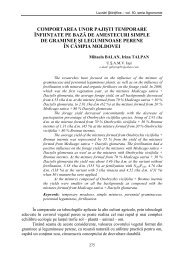environmental impact on yield of pea and okra grown under ...
environmental impact on yield of pea and okra grown under ...
environmental impact on yield of pea and okra grown under ...
Create successful ePaper yourself
Turn your PDF publications into a flip-book with our unique Google optimized e-Paper software.
Universitatea de Ştiinţe Agricole şi Medicină Veterinară Iaşi<br />
intercropping, WUE was improved significantly (Table 2A). The highest<br />
significant values <strong>of</strong> WUE obtained by <strong>pea</strong> as it was intercropped with <strong>okra</strong> <strong>under</strong><br />
1:2 <strong>and</strong> 2:1 row arrangements were due to the highest significant <strong>yield</strong>s <strong>of</strong> <strong>pea</strong> as<br />
compared to its sole crop (Table3), since WUE was calculated by dividing <strong>yield</strong><br />
over ET. It is believed that the higher <strong>yield</strong> <strong>of</strong> <strong>pea</strong> obtained <strong>under</strong> intercropping<br />
system was due to the interacti<strong>on</strong>s am<strong>on</strong>g different certain factors.<br />
Effect <strong>of</strong> Intercropping Okra / Pea <strong>on</strong> Air <strong>and</strong> Soil Heat Units VS Okra<br />
Yield<br />
When <strong>okra</strong> was planted with <strong>pea</strong> <strong>under</strong> 1:1, 1:2, 2:1 <strong>and</strong> 2:2 row<br />
arrangements, the soil <strong>and</strong> air heat unit values were higher than the values obtained<br />
by <strong>okra</strong> sole crop (Table 1B). However, am<strong>on</strong>g the above menti<strong>on</strong>ed treatments,<br />
the last three treatments gave significant higher values <strong>of</strong> both soil <strong>and</strong> air heat<br />
units as compared to the values obtained by <strong>okra</strong> sole crop. This could be attributed<br />
to wider spacing between rows, where the incident radiati<strong>on</strong> could penetrate<br />
through the intercropped <strong>okra</strong> plants to the soil surface. While <strong>okra</strong> planted as sole<br />
crop has a dense canopy <strong>and</strong> therefore less incident radiati<strong>on</strong> passes through all the<br />
leaves al<strong>on</strong>g <strong>okra</strong> stem. This might explain the higher values <strong>of</strong> both soil <strong>and</strong> air<br />
heat units obtained <strong>under</strong> <strong>okra</strong> intercropping as compared to <strong>okra</strong> sole cropping.<br />
When a comparis<strong>on</strong> between the two cropping systems (intercropping <strong>and</strong> sole<br />
cropping) regarding both air <strong>and</strong> soil heat units (Table 1B) in relati<strong>on</strong> to <strong>okra</strong> <strong>yield</strong><br />
(Table 3), two hypotheses can be drawn. The first, when air <strong>and</strong> soil heat units<br />
were significantly increased <strong>under</strong> intercropped <strong>okra</strong> as compared with <strong>okra</strong> sole<br />
cropping (such as in 1:2, 2:1 <strong>and</strong> 2:2 <strong>okra</strong> / <strong>pea</strong> intercropping row arrangements),<br />
the highest significant <strong>yield</strong>s were obtained, where an increase in <strong>yield</strong> <strong>of</strong> 64%,<br />
58.3% <strong>and</strong> 47.5%, respectively, over the <strong>yield</strong> <strong>of</strong> <strong>okra</strong> sole cropping. The sec<strong>on</strong>d,<br />
when soil <strong>and</strong> air heat unit values <strong>under</strong> intercropped <strong>okra</strong> plants were not<br />
statistically different with the values obtained by <strong>okra</strong> sole cropping (such as in 1:1<br />
<strong>okra</strong> / <strong>pea</strong> row arrangement), in this case the <strong>okra</strong> <strong>yield</strong> <strong>under</strong> intercropping <strong>and</strong><br />
sole cropping were also not statistically different. Similar results were obtained by<br />
Sharaiha <strong>and</strong> Battikhi (2002), in their work <strong>on</strong> corn / potato intercropping.<br />
Moreover, there is another factor which might affected <strong>okra</strong> <strong>yield</strong> producti<strong>on</strong><br />
positively, namely the associated <strong>pea</strong> crop that is capable <strong>of</strong> fixing atmospheric<br />
nitrogen will have a beneficial effect <strong>on</strong> <strong>okra</strong> which is n<strong>on</strong>-legume crop. This fact<br />
has been indicated in many reports. (Francis <strong>and</strong> S<strong>and</strong>ers 1978, Ray <strong>and</strong> Mc<br />
Fadden 1991, Sharaiha <strong>and</strong> Klus<strong>on</strong> 1994)<br />
Effect <strong>of</strong> Intercropping Okra / Pea <strong>on</strong> Light intercepti<strong>on</strong> VS Okra Yield<br />
Table 1A, shows that <strong>okra</strong> planted in associati<strong>on</strong> with <strong>pea</strong> <strong>under</strong> 1:1, 1:2, 2:1<br />
<strong>and</strong> 2:2 row arrangements intercepted more light than <strong>okra</strong> sole crop. However,<br />
significant higher values <strong>of</strong> light intercepti<strong>on</strong> were obtained when <strong>okra</strong> was planted<br />
with <strong>pea</strong> <strong>under</strong> 1:2, 2:1 <strong>and</strong> 2:2, where it gave an increase <strong>of</strong> 305 µmol.m¯²s¯¹, 150<br />
µmol.m¯²s¯¹ <strong>and</strong> 223 µmol.m¯²s¯¹ respectively, over the light intercepti<strong>on</strong> value<br />
obtained by <strong>okra</strong> sole crop. The higher values <strong>of</strong> light intercepti<strong>on</strong> obtained by <strong>okra</strong><br />
intercropped with <strong>pea</strong> were due to wider spacing between rows. On the other h<strong>and</strong>,<br />
the highest significant values <strong>of</strong> light intercepti<strong>on</strong> obtained by <strong>okra</strong> as it was<br />
318


